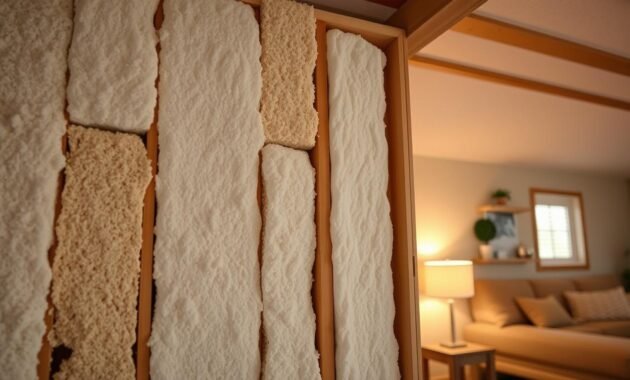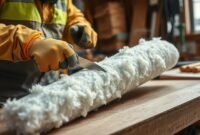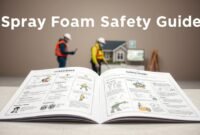As a mobile home owner, I’ve learned that the underbelly is key. It’s often ignored but plays a big role in keeping my home warm and energy-efficient. Studies show that good underbelly insulation can cut down on heat loss by up to 11%. This can save me a lot on my yearly utility bills.
But what does it take to keep this important part of my home in top shape? Let’s explore the world of mobile home underbelly insulation together.
Key Takeaways
- The underbelly of a mobile home is a vital part that insulates and protects.
- Good underbelly insulation can cut down on heat loss by up to 11%, saving a lot of money.
- Knowing about the belly board, vapor barrier, and insulation layers is key for upkeep and upgrades.
- Picking the right insulation, like fiberglass or spray foam, boosts thermal resistance and energy efficiency.
- Fixing air leaks and moisture issues in the underbelly is essential for long-term comfort and protection.
Understanding Mobile Home Underbelly Components
The underbelly of a mobile home is key to its structure, energy use, and lifespan. It’s often ignored by homeowners, but it’s very important. This layer is under the floor and helps keep the home strong and efficient.
Belly Board and Vapor Barrier Basics
The belly board, or blackboard, is the black material at the bottom of a mobile home. It acts as a vapor barrier, stopping moisture and protecting the home. Keeping it in good shape is vital to keep the home dry and safe from water damage.
Insulation Layers and Protection Systems
Insulation goes above the belly wrap to control temperature and save energy. Materials like mobile home insulation floor, spray foam insulation under mobile home, and under trailer insulation keep the inside warm or cool. This helps the HVAC system work less and cuts down on energy costs.
Structure and Support Elements
The underbelly also has floor joists, steel chassis, piers, and footers. These support the mobile home and keep it stable. They must be well-kept to avoid safety problems.
Knowing about the mobile home underbelly is the first step to caring for it. By focusing on these key parts, homeowners can protect their investment, save on energy, and live more comfortably.
The Importance of Proper Underbelly Maintenance
Keeping your mobile home’s underbelly in good shape is key. It helps save energy, keeps you comfortable, and guards against moisture and pests. If you ignore this area, you might face higher bills, cold spots, and harm to your plumbing and electrical systems.
Taking care of your underbelly can cut down on heating and cooling costs, make the air inside better, and help your home last longer.
The underbelly of a mobile home does a lot. It holds the insulation that keeps your home warm or cool, stopping heat from escaping and air from getting in. It also keeps your home safe from moisture and pests, stopping mold, rot, and infestations that can harm your home’s structure.
It’s important to check and maintain your mobile home’s underbelly often. Look for damage like holes, tears, or sagging and fix them right away. If you don’t, your insulation and air sealing will get worse. This makes it harder to keep your home at a comfortable temperature.
Investing in spray insulation under mobile home and the best insulation for mobile home underbelly makes your home more energy-efficient, comfortable, and safe. Regular upkeep and quick fixes to your underbelly can lower your utility bills, avoid expensive repairs, and keep your home’s value up over time.
Types of Mobile Home Underbelly Insulation
There are several options for insulating your mobile home’s underbelly. Fiberglass, foam board, and spray foam are popular choices. They help with mobile home wall insulation and installing insulation under a mobile home.
Read also: 4 Recommendations of Best Adhesive for Foam Board
Fiberglass Insulation Options
Fiberglass insulation is affordable and widely used. It’s non-flammable and traps air well. But, it’s important to handle it carefully to avoid skin irritation.
Foam Board Insulation Varieties
Foam board insulation, like EPS or XPS, is good at keeping warm in and cold out. It’s also light and easy to cut and install. ISO foam board is another type that insulates well.
Spray Foam Applications
Spray foam is great for filling gaps and creating a tight seal. It’s a good choice for mobile home underbellies. But, it needs special equipment and can cost more.
When picking insulation, think about your climate, moisture, R-value, and how easy it is to install. Clean the area, seal gaps, and protect the insulation for the best results.
| Insulation Type | R-Value | Advantages | Disadvantages |
|---|---|---|---|
| Fiberglass | R-11 to R-19 |
|
|
| Foam Board | R-4 to R-8 per inch |
|
|
| Spray Foam | R-6 to R-7 per inch |
|
|

Signs Your Mobile Home Needs Underbelly Repair
As a mobile homeowner, it’s important to watch your home’s underbelly closely. This hidden part is key to keeping your home safe from the weather and saving energy. If you see any of these signs, it might be time for underbelly repair.
- Cold drafts near the floor: Drafty areas around the base of your mobile home can indicate issues with the underbelly insulation or sealing.
- Increased energy bills: If your heating and cooling costs have risen without explanation, it could be a sign of air leaks or poor insulation in the underbelly.
- Visible damage to the belly wrap: Tears, holes, or sagging in the belly wrap material can compromise its protective function.
- Pest infestations: Rodents, insects, or other pests gaining access to the underbelly can cause significant damage and require immediate attention.
- Musty odors: Unpleasant smells coming from the underbelly may signify moisture buildup or mold growth, which can pose health risks.
Read also: 3 Blown In Fiberglass Insulation Problems
Regular checks of your mobile home’s underbelly can help spot and fix problems early. By keeping your underbelly in good shape, you can save energy, avoid expensive fixes, and keep your home safe and comfortable.
Fixing underbelly issues quickly can save you time, money, and trouble later. Whether you do it yourself or get help from a pro, taking care of your underbelly is a smart move for your mobile home’s health.
Step-by-Step Underbelly Installation Process
Insulating your mobile home’s underbelly is key for energy efficiency and comfort. I’ll walk you through the steps to protect your home well.
First, I’ll remove the old insulation. This lets me check the subfloor for damage and fix it. Then, I’ll install new insulation, like R-19 fiberglass batts, to block heat.
- Check and adjust the pier levels, anchor ties, and ductwork for support and alignment.
- Seal around pipes, wires, or ducts to stop air leaks.
- Put on a new belly wrap material under the mobile home, making sure seams overlap and are tight.
I might use spray foam for small or tricky spots. This adds a tight seal for better insulation.
By following these steps, your mobile home’s underbelly will be well-insulated and sealed. This ensures energy efficiency and long-lasting performance.

Common Underbelly Insulation Mistakes to Avoid
Insulating your mobile home’s underbelly can be tricky. There are common mistakes that can make your insulation less effective. These errors can even cause bigger problems later. Let’s look at what to avoid.
Read also: Is Blown-In Mineral Wool Insulation Effective?
Installation Errors
- Improper sealing of the belly wrap: If you don’t seal the edges and seams well, air can leak. This makes your insulation less effective.
- Neglecting moisture management: Not dealing with moisture before insulation can lead to mold and mildew.
- Inadequate securement: If you don’t secure the insulation properly, it can sag or shift. This reduces its performance.
- Compressing the insulation: Pressing down on the insulation can lower its R-value. This makes it less effective.
Material Selection Issues
Choosing the right insulation for your mobile home is key. It depends on your climate and needs. Some common mistakes include:
- Using insufficient insulation: If you choose insulation that doesn’t offer enough thermal protection, your home may lose or gain heat.
- Selecting the wrong insulation type: Different materials, like fiberglass or foam, perform differently. Picking the wrong one can affect how well it works.
- Failing to address ventilation needs: Not ensuring proper ventilation can cause moisture buildup. This can harm your insulation’s performance over time.
To avoid these mistakes, research well and consult experts. A well-planned insulation project can save you money and keep your home comfortable and energy-efficient for years.
Read also: R49 Batt Insulation: Best Home Comfort Solution
Professional vs DIY Installation Considerations
Insulating your mobile home’s underbelly can be done two ways: by a pro or DIY. Some homeowners might want to do it themselves to save money. But, there are important things to think about before making a choice.
Going with a pro, like Metro NY Insulation, means the job is done correctly the first time. Experts have the right skills and tools. They use the best insulation for mobile home roof or mobile home insulation blanket, ensuring top-notch protection against air leaks, moisture, and pests.
Professional installation might cost more upfront. But, the long-term benefits are worth it. Good insulation saves energy, lowering your bills and making your HVAC system more efficient. It also helps your insulation last longer, avoiding problems like sagging or settling.
DIY installation might save you money upfront. Yet, it has its own set of challenges. Working under a mobile home is hard, and without the right knowledge, you might not install it correctly. This could lead to costly repairs later, making any short-term savings not worth it.
| Consideration | Professional Installation | DIY Installation |
|---|---|---|
| Expertise | Experienced technicians with specialized knowledge | Limited experience and knowledge |
| Installation Quality | Proper techniques and high-quality materials | Risk of improper installation and use of subpar materials |
| Long-term Savings | Increased energy efficiency and extended lifespan | Potential for future repairs and maintenance |
| Cost | Higher upfront cost but potentially better long-term savings | Lower upfront cost but possible higher long-term expenses |
Choosing between professional or DIY installation for your mobile home’s underbelly insulation depends on your budget, DIY skills, and long-term goals. Talking to a trusted insulation company like Metro NY Insulation can help you make the best choice for your needs and ensure your insulation system works well.
Maintenance Tips for Long-Term Protection
Keeping your mobile home’s underbelly insulation in good shape is key. Regular checks and care can make your insulation last longer. This helps avoid expensive fixes later. Here are some important tips to keep your insulation working well.
- Inspect the underbelly regularly: It’s smart to regularly check your mobile home’s underbelly. Look for damage like tears, holes, or sagging. Fixing these problems fast stops them from getting worse and keeps water out.
- Address moisture issues quickly: Moisture in the underbelly can cause mold, mildew, and damage to insulation. Fix any water problems right away to keep your insulation strong.
- Ensure proper ventilation: Good airflow is key to stop moisture buildup and condensation. Make sure your mobile home’s vents are clear and working right.
- Keep the area clean: Clear out any debris, leaves, or stuff under your mobile home. A clean underbelly lets air flow better and keeps pests away.
- Monitor insulation levels: Check your mobile home’s belly wrap and insulation levels often. Add or replace insulation as needed to keep your home warm and cozy.
By following these tips, you can make your mobile home’s underbelly insulation last longer. This means better energy use, comfort, and protection for your home. Taking good care of this important part can really help your mobile home stay in great shape.
Conclusion
Insulation under your mobile home is key for comfort, energy savings, and keeping it strong. Knowing about the underbelly system and picking the right insulation can make a big difference. It can also cut down your energy bills.
Choosing between fiberglass, foam board, or spray foam is important. Make sure it’s installed well to seal any gaps. Regular checks and quick fixes will keep your insulation working great, protecting your home and making it more comfortable.
Read also: Is Spray Foam Insulation Flammable?
By using the tips from this guide, you’ll make your mobile home more energy-efficient. You could save up to 25% on cooling and heating. Plus, your home will stay at a steady temperature, making it worth the investment.


